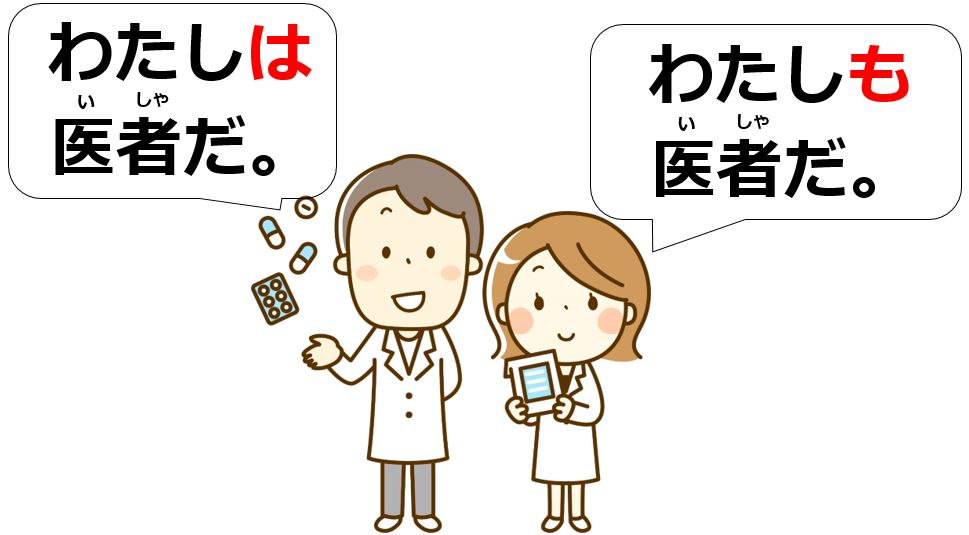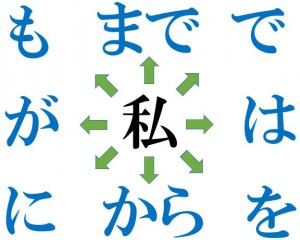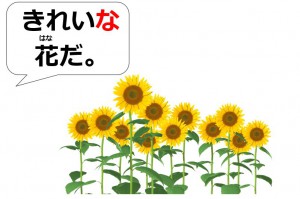Last time, you learned how to express state-of-being with Japanese nouns like “学生だ ([I’m a] student.)” In Japanese, sentences without subjects are very common when contexts clearly tell what or who you are referring to. Then, what should you do when it is not clear what you are talking about? In this article, you will learn how to use the topic particle は and the particle も.
Expressing a Topic with the Topic Particle は and the Particle も
In Japanese, being able to use particles correctly (you will learn more later on) has a significant importance on determining whether a sentence makes sense or not. Take it easy. The number of the major particles is approximately ten. Let’s see how it works one by one.
The Topic Particle は
| 私は学生(だ / です)。 I’m a student. |
| 山田さんは先生(じゃない / じゃありません)。 Yamada-san is not a teacher. |
| ボブはアメリカ人(だ / です)。 Bob is an American. |
The topic particle は is always pronounced as わ and placed after a word that you want to make a topic. This has a function that separates a sentence into two sections: Topic and Predicate. In general, the topic particle は should be used once in a sentence.
| 私は | 学生(だ / です) |
| Topic / Subject | Predicate |
When a Subject Differs from a Topic
Although a topic set by は can be a subject at the same time, it’s not necessarily that they are the same in a sentence and this structure is common in Japanese. *You will learn how adjectives work in the next lesson.
| 色は | 赤色が | きれい(だ / です) |
| Topic | Subject | Predicate |
| As for colors, red is beautiful. | ||
| ごはんは | 寿司が | 美味しい(です) |
| Topic | Subject | Predicate |
| As for meals, Sushi is delicious. | ||
[adsense]
The Particle も
The particle も has a function expressing “inclusion” and is placed after a word when you want to emphasize inclusion. The particle も can be translated as “too” or “also.” Let’s check the following examples.
| 色は | 青色も | きれい(だ / です) |
| Topic | Subject (Inclusion) | Predicate |
| As for colors, blue is also beautiful. *It implies that there are other beautiful colors. |
||
| 夜ごはんも | 寿司が | いい(です) |
| Topic (Inclusion) | Subject | Predicate |
| As for dinner, Sushi is good, too. *It implies that he thinks Sushi is good for lunch or breakfast. |
||
More Examples
| 名前はボブ(じゃない / じゃありません)。 [My] name is not Bob. |
| 私もボブ(じゃない / じゃありません)。 I’m not Bob, too. |
| 歌は芸術(だ / です)。 Songs are the arts. |
| 絵も芸術(だ / です)。 Drawings are also the arts. |
| 大学は東京大学がいい(です)。 As for universities, the University of Tokyo is good. |
| 病院も東京病院がいい(です)。 As for hospitals, the Hospital of Tokyo is good, too. |
| ホテルは京都ホテルもいい(です)。 As for hotels, Kyoto Hotel is good, too. |
Summary
- The topic particle は works as “X is …”
- The topic particle は also works as “As for X, … is …”
- The particle も can express “inclusion”
Now, you can set a topic and express what the topic is like. Next, you will learn how Japanese adjectives work in order to make your sentences more colorful.





